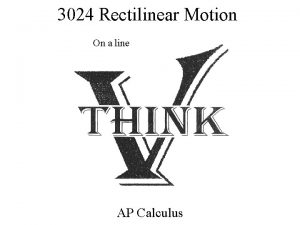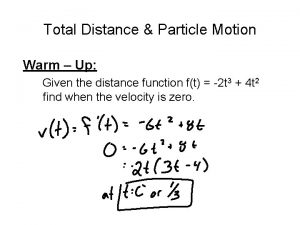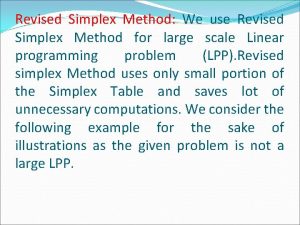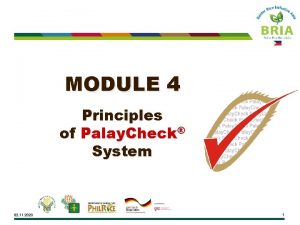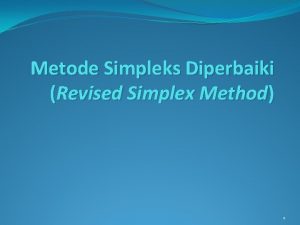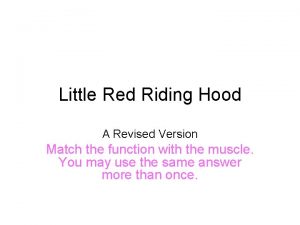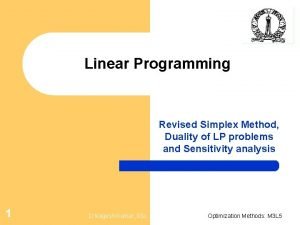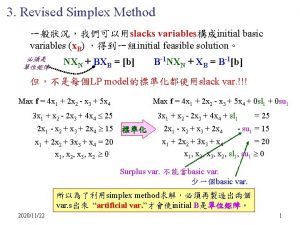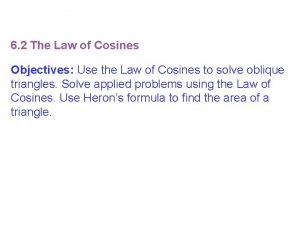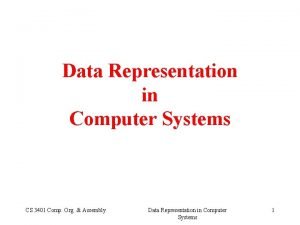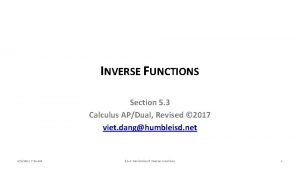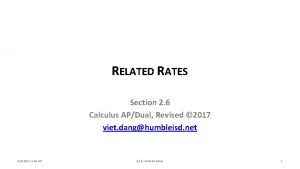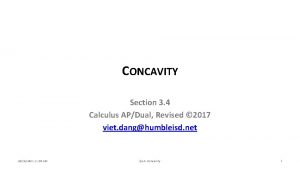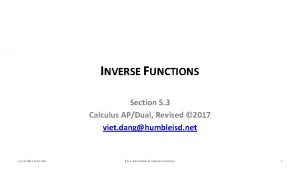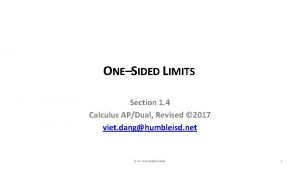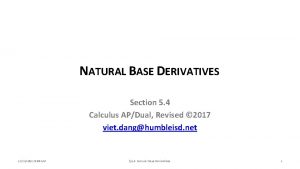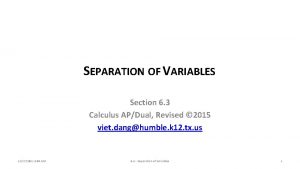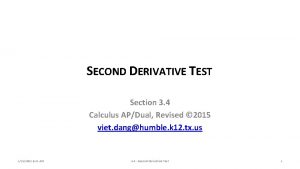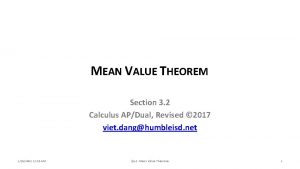PARTICLE MOTION Section 3 7 Calculus APDual Revised













































- Slides: 45

PARTICLE MOTION Section 3. 7 Calculus AP/Dual, Revised © 2013 viet. dang@humble. k 12. tx. us 10/26/2021 7: 55 AM 3. 7 – Particle Motion 1

WHAT IS POSITION, VELOCITY, AND ACCELERATION? www. nbclearn. com/nfl/cuecard/50770 10/26/2021 7: 55 AM 3. 7 – Particle Motion 2

MOTIONS A. Position known as s(t) or x(t); also known as speed is the rate of motion 1. 2. 3. Label could be known as meters “Initially” means when t = 0 “At the origin” means x(t) = 0 1. 2. 3. 4. 5. Label could be known as meters/second or speed/time “At rest” means v(t) = 0 If the velocity of the particle is positive, then the particle is moving to the right If the velocity of the particle is negative, then the particle is moving to the left If the order of the particle changes direction, the velocity must change signs 1. 2. 3. 4. Label could be known as meters/second 2 or velocity/time If the acceleration of the particle is positive, then the particle is increasing If the acceleration of the particle is negative, then the particle is decreasing If a particle slows down, signs from v’(t) and s’’(t) are different (SIGNS DIFFERENT) B. Velocity known as v(t) = s’(t); abs value rate of motion or known as SPEED and DIRECTION C. Acceleration known as a(t) = v’(t) = s’’(t) 10/26/2021 7: 55 AM 3. 7 – Particle Motion 3

FORMULAS 10/26/2021 7: 55 AM 3. 7 – Particle Motion 4

GRAPH 10/26/2021 7: 55 AM 3. 7 – Particle Motion 5

WEBSITE http: //www. cengage. com/math/discipline_content/stewartcal cet 7/2008/14_cengage_tec/publish/deployments/transcend entals_7 e/m 3_7_sa. swf http: //phet. colorado. edu/simulations/sims. php? sim=The_Mov ing_Man 10/26/2021 7: 55 AM 3. 7 – Particle Motion 6

GEOMETRIC SKETCHPAD 10/26/2021 7: 55 AM 3. 7 – Particle Motion 7

EXAMPLE 1 A 10/26/2021 7: 55 AM 3. 7 – Particle Motion 8

EXAMPLE 1 B 10/26/2021 7: 55 AM 3. 7 – Particle Motion 9

EXAMPLE 1 C 10/26/2021 7: 55 AM 3. 7 – Particle Motion 10

EXAMPLE 1 D 10/26/2021 7: 55 AM 3. 7 – Particle Motion 11

EXAMPLE 2 A 10/26/2021 7: 55 AM 3. 7 – Particle Motion 12

EXAMPLE 2 B 10/26/2021 7: 55 AM 3. 7 – Particle Motion 13

EXAMPLE 2 C 10/26/2021 7: 55 AM 3. 7 – Particle Motion 14

EXAMPLE 2 D 10/26/2021 7: 55 AM X=0 (0, 1/3) X = 1/3 (1/3, 6) X=6 (6, ∞) f(0) (0, -7) f ’(1/4) (-)(-) POSITIVE RIGHT f(1/3) (1/3, 136/27) Rel MAX f ’(2) (+)(-) NEGATIVE LEFT f(6) (6, 187) Rel MIN f ’(7) (+)(+) POSITIVE RIGHT 3. 7 – Particle Motion 15

EXAMPLE 2 E 10/26/2021 7: 55 AM X=0 (0, 1/3) X = 1/3 (1/3, 6) X=6 (6, ∞) f(0) (0, 7) f ’(1/4) (-)(-) POSITIVE RIGHT f(1/3) (1/3, 136/27) Rel MAX f ’(2) (+)(-) NEGATIVE LEFT f(6) (6, 187) Rel MIN f ’(7) (+)(+) POSITIVE RIGHT 3. 7 – Particle Motion 16

EXAMPLE 2 F 10/26/2021 7: 55 AM 3. 7 – Particle Motion 17

EXAMPLE 2 G X = 0 f(0) (0, 7) (0, 1/3) f ’(1/4) (-)(-) POSITIVE f ” (x) = 12 t – 38 RIGHT 10/26/2021 7: 55 AM (0, 19/6) X = 1/3 f ” (1)f(1/3) (1/3, (-) -136/27) NEGATIVE Rel MAX (1/3, X 6)= 19/6 X=6 f ’(2) f ” (19/6) (+)(-) NEGATIVE LEFT f(6) (6, 187) Rel MIN 3. 7 – Particle Motion (19/6, ∞) (6, ∞) f ”(4) f ’(7) (+)(+) POSITIVE RIGHT 18

EXAMPLE 2 H 10/26/2021 7: 55 AM 3. 7 – Particle Motion t s(t) 0 – 7 1/3 – 5. 037 3 – 88 19

YOUR TURN 10/26/2021 7: 55 AM 3. 7 – Particle Motion 20

SPEED, VELOCITY, AND TANGENT LINES A. Speed is the absolute value of velocity. It is measured of how fast something is moving with the regard of direction B. The effect of how an absolute value function has it on the graph is that it reflects all values that are below the x-axis, above on the x-axis 10/26/2021 7: 55 AM 3. 7 – Particle Motion 21

EXAMPLE 3 For each situation, the graph is differentiable when giving velocity as a function of time [1, 5] along the selected values of the velocity. In this graph, each horizontal mark represents 1 unit and each vertical mark represents 4 units. Plot the speed graph on the same coordinate plane as velocity. 10/26/2021 7: 55 AM 2. 2 A - Rate of Change Time Velocity Speed 1 1 1 2 2 2 3 4 4 4 8 8 5 16 16 22

EXAMPLE 3 For each situation, the graph is differentiable when giving velocity as a function of time [1, 5] along the selected values of the velocity. In this graph, each horizontal mark represents 1 unit and each vertical mark represents 4 units. Plot the speed graph on the same coordinate plane as velocity. A) In this situation, the velocity is positive/negative and increasing/decreasing? B) When velocity is increasing/decreasing, we know that acceleration is positive/negative? C) When examining the graph of speed and table of values, the conclusion is that speed is increasing/decreasing? 10/26/2021 7: 55 AM 2. 2 A - Rate of Change 23

EXAMPLE 4 For each situation, the graph is differentiable when giving velocity as a function of time [1, 5] along the selected values of the velocity. In this graph, each horizontal mark represents 1 unit and each vertical mark represents 4 units. Plot the speed graph on the same coordinate plane as velocity. 10/26/2021 7: 55 AM 2. 2 A - Rate of Change Time Velocity Speed 1 – 1 1 2 – 2 2 3 – 4 4 4 – 8 8 5 – 16 16 24

EXAMPLE 4 For each situation, the graph is differentiable when giving velocity as a function of time [1, 5] along the selected values of the velocity. In this graph, each horizontal mark represents 1 unit and each vertical mark represents 4 units. Plot the speed graph on the same coordinate plane as velocity. A) In this situation, the velocity is positive/negative and increasing/decreasing? B) When velocity is increasing/decreasing, we know that acceleration is positive/negative? C) When examining the graph of speed and table of values, the conclusion is that speed is increasing/decreasing? 10/26/2021 7: 55 AM 2. 2 A - Rate of Change 25

EXAMPLE 5 For each situation, the graph is differentiable when giving velocity as a function of time [1, 5] along the selected values of the velocity. In this graph, each horizontal mark represents 1 unit and each vertical mark represents 4 units. Plot the speed graph on the same coordinate plane as velocity. 10/26/2021 7: 55 AM 2. 2 A - Rate of Change Time Velocity Speed 1 – 16 16 2 – 8 8 3 – 4 4 4 – 2 2 5 – 1 1 26

EXAMPLE 5 For each situation, the graph is differentiable when giving velocity as a function of time [1, 5] along the selected values of the velocity. In this graph, each horizontal mark represents 1 unit and each vertical mark represents 4 units. Plot the speed graph on the same coordinate plane as velocity. A) In this situation, the velocity is positive/negative and increasing/decreasing? B) When velocity is increasing/decreasing, we know that acceleration is positive/negative? C) When examining the graph of speed and table of values, the conclusion is that speed is increasing/decreasing? 10/26/2021 7: 55 AM 2. 2 A - Rate of Change 27

EXAMPLE 6 For each situation, the graph is differentiable when giving velocity as a function of time [1, 5] along the selected values of the velocity. In this graph, each horizontal mark represents 1 unit and each vertical mark represents 4 units. Plot the speed graph on the same coordinate plane as velocity. 10/26/2021 7: 55 AM 2. 2 A - Rate of Change Time Velocity Speed 1 16 16 2 8 8 3 4 4 4 2 2 5 1 1 28

EXAMPLE 6 For each situation, the graph is differentiable when giving velocity as a function of time [1, 5] along the selected values of the velocity. In this graph, each horizontal mark represents 1 unit and each vertical mark represents 4 units. Plot the speed graph on the same coordinate plane as velocity. A) In this situation, the velocity is positive/negative and increasing/decreasing? B) When velocity is increasing/decreasing, we know that acceleration is positive/negative? C) When examining the graph of speed and table of values, the conclusion is that speed is increasing/decreasing? 10/26/2021 7: 55 AM 2. 2 A - Rate of Change 29

YOUR TURN A. For which Examples 3 to 6 was the speed increasing? Explain. B. When the spend in increasing, the velocity and acceleration have same/opposite signs? C. For which Examples 3 to 6 was the speed increasing? Explain. D. When the spend in increasing, the velocity and acceleration have same/opposite signs? 10/26/2021 7: 55 AM 2. 2 A - Rate of Change 30

EXAMPLE 7 The graph below represents the velocity, v(t), in feet per second, of a particle moving along the x-axis over the time interval from t = 0 and t = 11 seconds. It consists of a semicircle and two line segments. A) B) C) D) At what time [0, 11], is the speed of the particle the greatest? At which times, t = 2, t = 6, or t = 9 where the acceleration the greatest? Explain. Over what time intervals is the particle moving left? Explain. Over what time intervals is the speed of the particle decreasing? Explain. 10/26/2021 7: 55 AM 2. 2 A - Rate of Change 31

EXAMPLE 7 A The graph below represents the velocity, v, in feet per second, of a particle moving along the x-axis over the time interval from t = 0 and t = 9 seconds. At what time [0, 11], is the speed of the particle the greatest? 10/26/2021 7: 55 AM 2. 2 A - Rate of Change 32

EXAMPLE 7 B The graph below represents the velocity, v, in feet per second, of a particle moving along the x-axis over the time interval from t = 0 and t = 9 seconds. At which times, t = 2, t = 6, or t = 9 where the acceleration the greatest? Explain. 10/26/2021 7: 55 AM 2. 2 A - Rate of Change 33

EXAMPLE 7 C The graph below represents the velocity, v, in feet per second, of a particle moving along the x-axis over the time interval from t = 0 and t = 9 seconds. Over what time intervals is the particle moving left? Explain. 10/26/2021 7: 55 AM 2. 2 A - Rate of Change 34

EXAMPLE 7 D The graph below represents the velocity, v, in feet per second, of a particle moving along the x-axis over the time interval from t = 0 and t = 9 seconds. Over what time intervals is the speed of the particle decreasing? Explain. 10/26/2021 7: 55 AM 2. 2 A - Rate of Change 35

EXAMPLE 8 The graph below represents the velocity, v(t), in feet per second, of a particle moving along the x-axis over the time interval from t = 0 and t = 11 seconds. It consists of a semicircle and two line segments. A) B) C) D) If t = 4, is the particle moving to the right or left? Explain the answer. Over what time interval is the particle moving to the left? Explain. At t = 4 seconds, is the acceleration of the particle positive or negative? Explain. Is there guaranteed to be a time t in the interval, [2, 4] such that v’(t) = – 3/2 ft/sec 2? Justify answer. 10/26/2021 7: 55 AM 2. 2 A - Rate of Change 36

EXAMPLE 8 A The graph below represents the velocity, v, in feet per second, of a particle moving along the x-axis over the time interval from t = 0 and t = 9 seconds. If t = 4, is the particle moving to the right or left? Explain the answer. 10/26/2021 7: 55 AM 2. 2 A - Rate of Change 37

EXAMPLE 8 B The graph below represents the velocity, v, in feet per second, of a particle moving along the x-axis over the time interval from t = 0 and t = 9 seconds. Over what time interval is the particle moving to the left? Explain. 10/26/2021 7: 55 AM 2. 2 A - Rate of Change 38

EXAMPLE 8 C The graph below represents the velocity, v, in feet per second, of a particle moving along the x-axis over the time interval from t = 0 and t = 9 seconds. At t = 4 seconds, is the acceleration of the particle positive or negative? Explain. 10/26/2021 7: 55 AM 2. 2 A - Rate of Change 39

EXAMPLE 8 D The graph below represents the velocity, v, in feet per second, of a particle moving along the x-axis over the time interval from t = 0 and t = 9 seconds. Is there guaranteed to be a time t in the interval, [2, 4] such that v’(t) = – 3/2 ft/sec 2? Justify answer. 10/26/2021 7: 55 AM 2. 2 A - Rate of Change 40

EXAMPLE 9 The data below in the table gives the selected values of velocity, in meters/minute, of a particle moving along the x-axis. The velocity v is differentiable function of time, t. A) If t = 0, is the particle moving to the right or left? Explain the answer. B) Is there a time during the interval [0, 12] minutes when the particle is at rest? Explain answer. C) Use the data from the table to approximate v’(10) and explain the meaning of v’(10) in terms of the motion of the particle. 10/26/2021 7: 55 AM 2. 2 A - Rate of Change 41

EXAMPLE 9 A The data below in the table gives the selected values of velocity, in meters/minute, of a particle moving along the x-axis. The velocity v is differentiable function of time, t. If t = 0, is the particle moving to the right or left? Explain the answer. 10/26/2021 7: 55 AM 2. 2 A - Rate of Change 42

EXAMPLE 9 B The data below in the table gives the selected values of velocity, in meters/minute, of a particle moving along the x-axis. The velocity v is differentiable function of time, t. Is there a time during the interval [0, 12] minutes when the particle is at rest? Explain answer. 10/26/2021 7: 55 AM 2. 2 A - Rate of Change 43

EXAMPLE 9 C The data below in the table gives the selected values of velocity, in meters/minute, of a particle moving along the x-axis. The velocity v is differentiable function of time, t. Use the data from the table to approximate v’(10) and explain the meaning of v’(10) in terms of the motion of the particle. 10/26/2021 7: 55 AM 2. 2 A - Rate of Change 44

YOUR TURN Rocket A has positive velocity v(t) after being launched upward from an initial height of 0 feet at time t = 0 seconds. The velocity of the rocket is recorded for selected values of t over the interval 0 < t < 80 seconds, as shown in the table. A) If t = 0, is the particle moving to the right or left? Explain the answer. B) Find the average acceleration of Rocket A over the time interval, [0, 80]. C) Use the data from the table to approximate v’(15) and explain the meaning of v’(15) in terms of the motion of the particle. 10/26/2021 7: 55 AM 3. 7 – Particle Motion 45
 Chapter 2 section 1 describing motion answer key
Chapter 2 section 1 describing motion answer key The main difference between speed and velocity involves
The main difference between speed and velocity involves Section 1 describing motion
Section 1 describing motion Chapter 1 lesson 2 describing motion answer key
Chapter 1 lesson 2 describing motion answer key Motion section 1 describing motion
Motion section 1 describing motion Rectilinear motion calculus
Rectilinear motion calculus Revised section 508 standards
Revised section 508 standards Total distance traveled
Total distance traveled What is active range of motion
What is active range of motion Simple harmonic motion formula
Simple harmonic motion formula An object in motion stays in motion
An object in motion stays in motion Bp 202 form 2021
Bp 202 form 2021 Betts neihart profiles of the gifted and talented
Betts neihart profiles of the gifted and talented Revised primary curriculum grade 1-3
Revised primary curriculum grade 1-3 Revised simplex method
Revised simplex method Accountability assessment tool
Accountability assessment tool Fiscal incentives for industrial promotion (revised)-2013
Fiscal incentives for industrial promotion (revised)-2013 Aup
Aup Littering orc
Littering orc Palaycheck system meaning
Palaycheck system meaning Metode revised simplex
Metode revised simplex Simplex method adalah
Simplex method adalah Little red riding hood a revised version answers
Little red riding hood a revised version answers Duality simplex method
Duality simplex method Revised trauma score
Revised trauma score Hvltr
Hvltr Cs form no. 33-b revised 2018
Cs form no. 33-b revised 2018 Revised trauma score italiano
Revised trauma score italiano Jugulovenous
Jugulovenous Revised trauma score
Revised trauma score Simplex tableau
Simplex tableau Flacc
Flacc Isa 540
Isa 540 Early childhood screening rochester mn
Early childhood screening rochester mn What can trigger spectator aggression in sport
What can trigger spectator aggression in sport Caltrans standard specifications
Caltrans standard specifications Brief visuospatial memory test revised
Brief visuospatial memory test revised Law of cosines sss
Law of cosines sss Isa 315 revised
Isa 315 revised Express (32)10 in the revised 14-bit floating-point model
Express (32)10 in the revised 14-bit floating-point model Yukl's multiple linkage model
Yukl's multiple linkage model 2021 revised curriculum and assessment plans
2021 revised curriculum and assessment plans 2020 revised curriculum and assessment plans
2020 revised curriculum and assessment plans 2021 revised curriculum and assessment plans
2021 revised curriculum and assessment plans 2020 revised curriculum and assessment plans
2020 revised curriculum and assessment plans Revised curriculum and assessment plans 2021
Revised curriculum and assessment plans 2021





